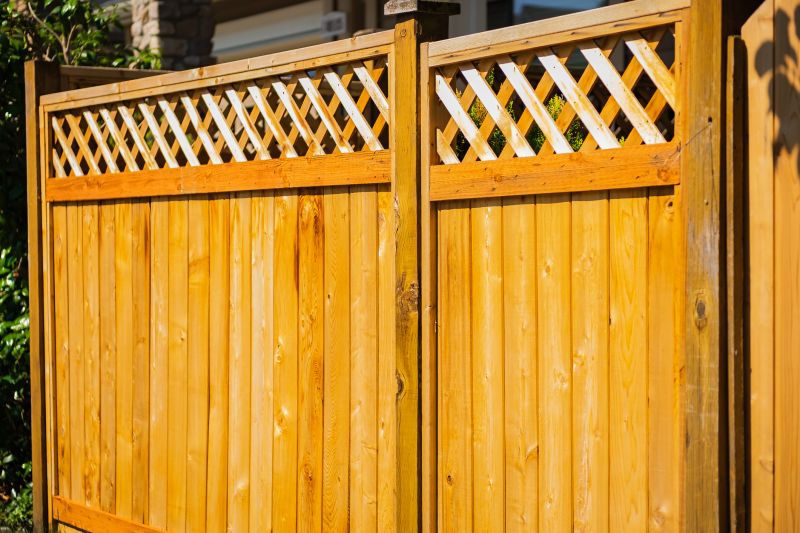Expert Picks For Lattice Replacement Materials To Transform Your Garden Area
Find the most recommended materials and products to upgrade your lattice, ensuring beauty and durability in outdoor environments.
 Replacing a lattice can transform the appearance and functionality of outdoor spaces, providing privacy, support for climbing plants, or a decorative element. When considering products for lattice replacements, it is important to evaluate the durability, material composition, and ease of installation of the options available. Many materials are designed to withstand weather conditions and require minimal maintenance, making them suitable for various climates and aesthetic preferences.
Replacing a lattice can transform the appearance and functionality of outdoor spaces, providing privacy, support for climbing plants, or a decorative element. When considering products for lattice replacements, it is important to evaluate the durability, material composition, and ease of installation of the options available. Many materials are designed to withstand weather conditions and require minimal maintenance, making them suitable for various climates and aesthetic preferences.
Top Overall Option
Versatile Lattice Panel
A versatile lattice panel made from durable composite material offers a blend of strength, weather resistance, and aesthetic flexibility. Its lightweight design allows for easy installation and customization, making it suitable for various outdoor settings. This option provides a long-lasting solution that can support climbing plants and enhance privacy without the need for frequent maintenance.
Types of Products For Lattice Replacments
Wooden Lattice Panels
Traditional wood lattice panels are popular for their classic appearance and ease of customization through staining or painting.
Vinyl Lattice Panels
Vinyl lattice offers low maintenance and weather resistance, ideal for long-term outdoor use.
Composite Lattice Panels
Composite materials provide durability, resistance to rot, and minimal upkeep, suitable for various climates.
Metal Lattice Panels
Metal options like aluminum or wrought iron add a modern touch and are known for their strength and longevity.
PVC Lattice Panels
PVC lattice is lightweight, weatherproof, and easy to install, often used for decorative purposes.
Bamboo Lattice Panels
Bamboo provides an eco-friendly, natural look with good strength and flexibility for outdoor applications.
Decorative Metal Grilles
Decorative metal grilles serve as stylish lattice replacements, offering intricate patterns and durability.
Plastic Mesh Panels
Plastic mesh panels are lightweight and affordable, suitable for temporary or decorative uses.
Climbing Plant Support Lattices
Specialized lattices designed to support climbing plants and vines, often made from sturdy wood or metal.
Adjustable Lattice Systems
Lattice systems with adjustable panels allow customization of privacy and airflow as needed.
Pergola Style Lattices
Lattices integrated into pergola structures provide shade and support for climbing plants.
Decorative Screen Panels
Decorative screen panels can serve as lattice replacements while adding artistic elements to outdoor spaces.
Popular Choices
Vinyl lattice panels are favored for their low maintenance and weather resistance, suitable for various outdoor settings.
Classic wooden lattice panels remain a popular choice for their natural look and ease of customization.
Composite options are chosen for their durability and minimal upkeep, especially in high-moisture areas.
Metal lattices, such as aluminum or wrought iron, are appreciated for their strength and longevity.
Bamboo provides a natural, eco-friendly aesthetic that is increasingly popular for outdoor privacy screens.
Intricate metal grilles are often selected for their decorative appeal and durability.
PVC panels are lightweight and resistant to weather, making them a common choice for quick installations.
Designed specifically to support climbing plants, these lattices are popular for garden aesthetics.
Flexible systems that allow customization of privacy and airflow are trending among outdoor enthusiasts.
Lattices incorporated into pergolas are frequently used to create shaded, plant-friendly outdoor spaces.
Lattice replacements come in a variety of styles and sizes, from traditional wood slats to modern composite panels. Wood options offer a classic look and can be painted or stained to match existing structures, while composite materials provide increased longevity and resistance to rot, insects, and warping. Metal lattices, such as aluminum or wrought iron, can add a sleek, contemporary touch and are often chosen for their strength and minimal upkeep.
Installation methods may vary depending on the product type, with some designs featuring simple mounting systems that can be attached to existing frameworks or walls. When selecting a lattice replacement, it is essential to consider the specific needs of your space, including the desired level of privacy, support for climbing plants, and overall aesthetic. Proper measurements and understanding of your existing structure will ensure a seamless fit and long-lasting results.
Overall, the right lattice replacement product can enhance outdoor privacy, provide support for greenery, and contribute to the visual appeal of your garden or patio. By choosing materials suited to your environment and style preferences, you can create a functional and attractive outdoor feature that complements your landscape design.
Key Buying Considerations
- Material durability and weather resistance suitable for your climate.
- Ease of installation and whether additional tools or expertise are required.
- Maintenance requirements, including cleaning and potential repainting or sealing.
- Aesthetic compatibility with existing outdoor structures and landscape design.
- Size and dimensions to ensure proper fit and coverage.
- Support for climbing plants if garden growth is a priority.
- Level of privacy provided by the lattice design.
- Resistance to pests, rot, and warping for long-term use.
- Cost and overall budget considerations for your project.
- Availability of customization options such as color, pattern, or finish.
- Compatibility with existing mounting systems or frameworks.
- Environmental factors like exposure to sun, rain, or snow that may influence material choice.
- Weight of the product for ease of handling and installation.
- Warranty or guarantee offered by the manufacturer or seller.
- Environmental impact or eco-friendliness if relevant to your preferences.
